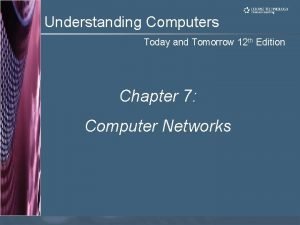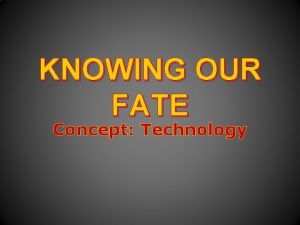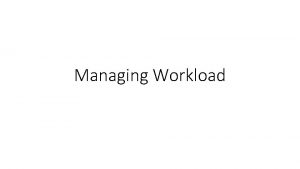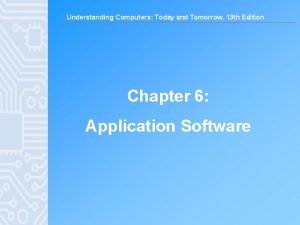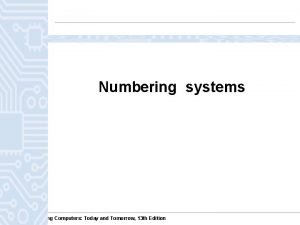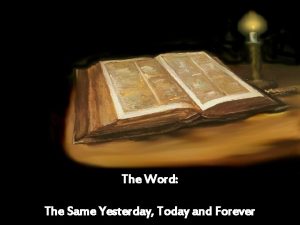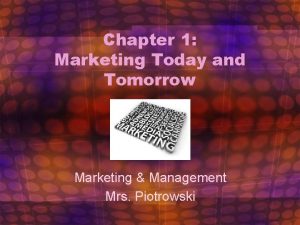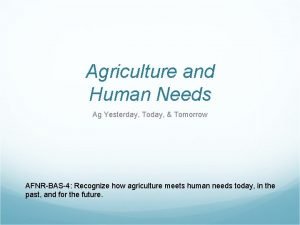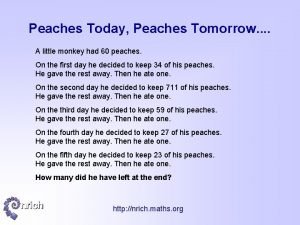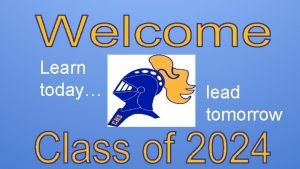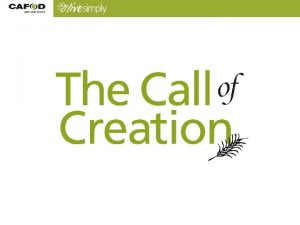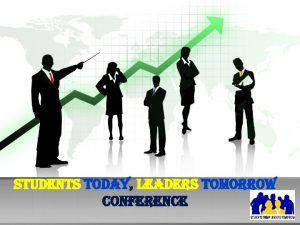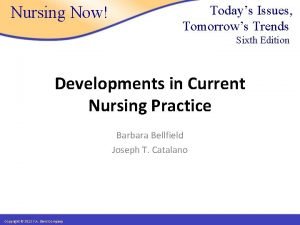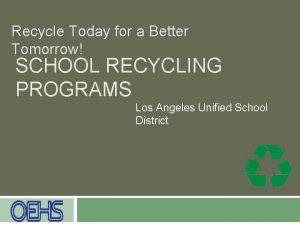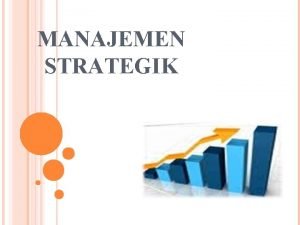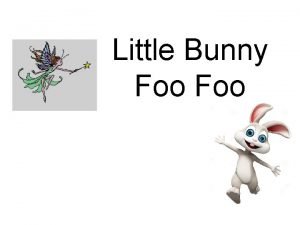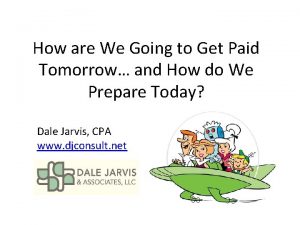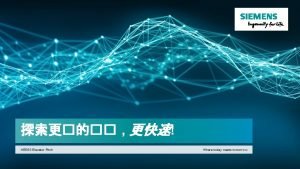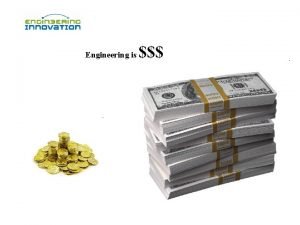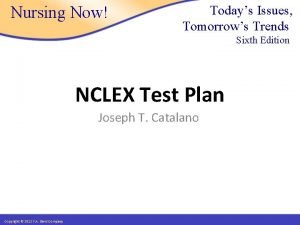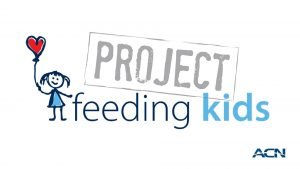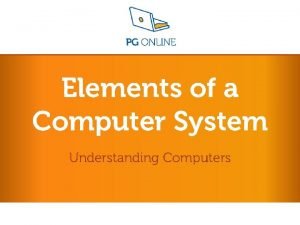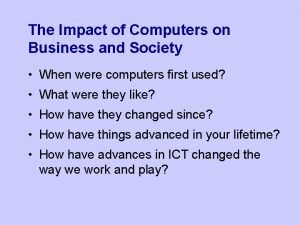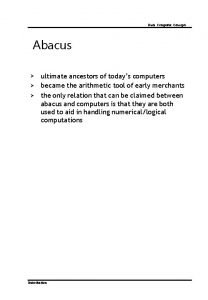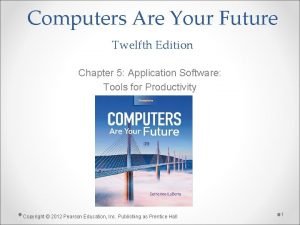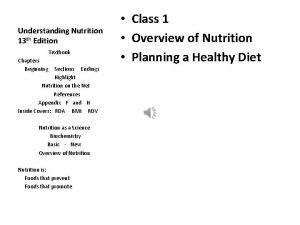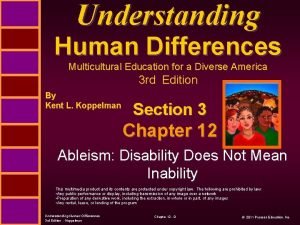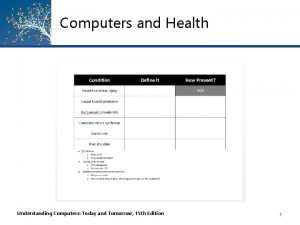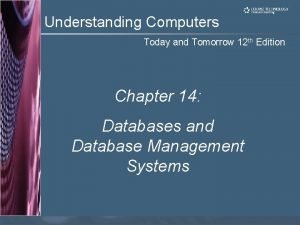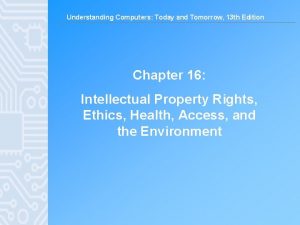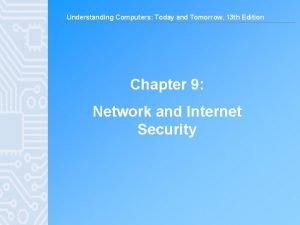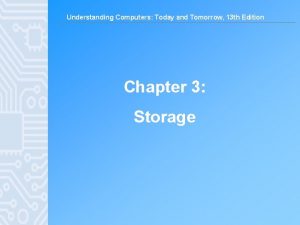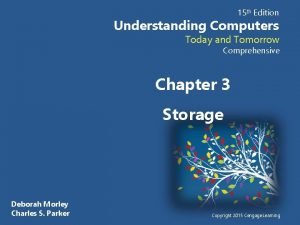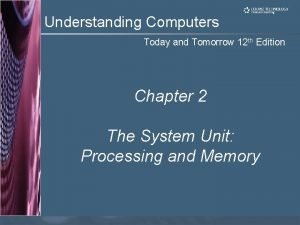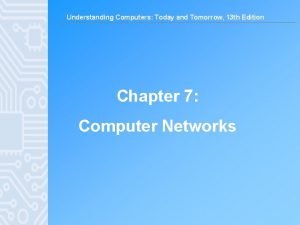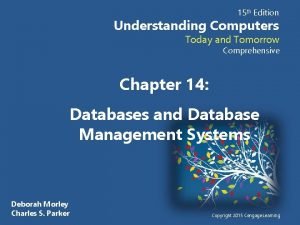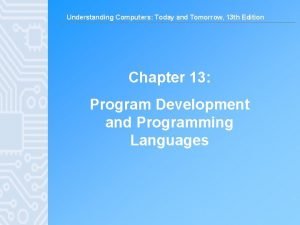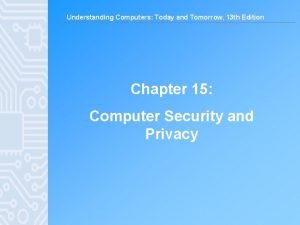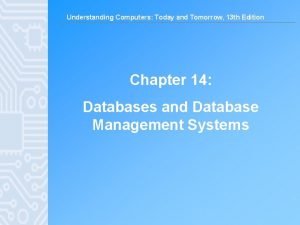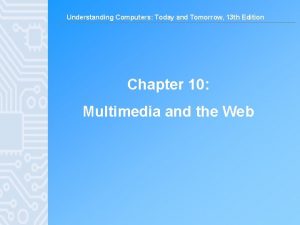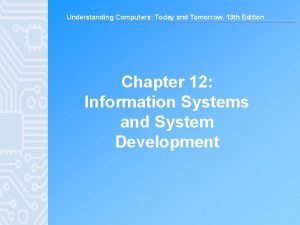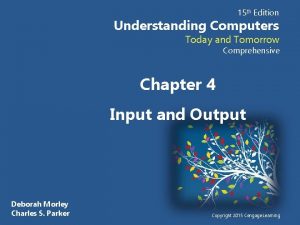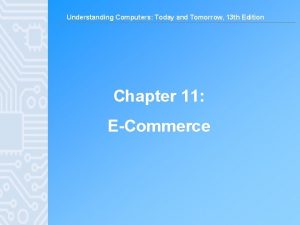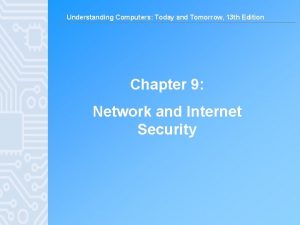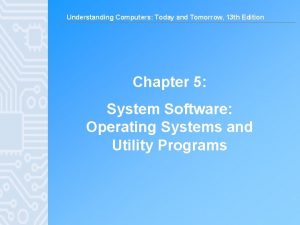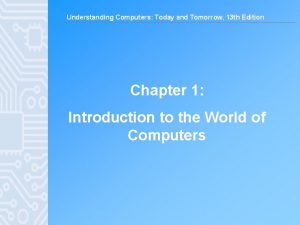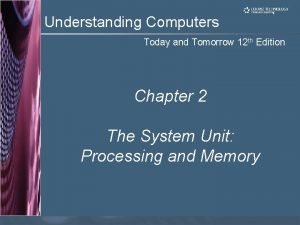Understanding Computers Today and Tomorrow 13 th Edition







































- Slides: 39

Understanding Computers: Today and Tomorrow, 13 th Edition Chapter 1: Introduction to the World of Computers

Computers in Your Life • Why learn about computers? – Pervasive computing • Also known as ubiquitous computing • Computers have become an integral part of our lives – Basic computer literacy • Knowing about and understanding computers and their uses is an essential skill today for everyone Understanding Computers: Today and Tomorrow, 13 th Edition 2

Computers in Your Life • Before 1980 – Computers were large, expensive – Very few people had access to them – Computers were mostly used for high-volume processing tasks • Microcomputers in the early 80 s – Inexpensive personal computers – Computer use increased dramatically • Today – More than 80% of US households include a computer, and most use computers at work – Electronic devices are converging into single units with multiple capabilities Understanding Computers: Today and Tomorrow, 13 th Edition 3

Computers in the Home • Computers used for a variety of tasks: – Looking up information and news – Exchanging e-mail – Shopping and paying bills – Watching TV and videos – Downloading music and movies – Organizing digital photographs – Playing games – Telecommuting Understanding Computers: Today and Tomorrow, 13 th Edition 4

Computers in the Home • Convergence – The computer has become the central part of home entertainment – Dual-mode mobile phones • Wireless networking – Computers can be used in nearly any location • Smart appliances – Traditional appliances with built-in computer or communication technology • Smart homes – Household tasks are monitored and controlled by a main computer in the house Understanding Computers: Today and Tomorrow, 13 th Edition 5

Computers on the Job • Computers have become a universal on-the-job tool for decision-making, productivity, and communication – Used by all types of employees – Used for access control and other security measures – Use by service professionals is growing – Used extensively by the military – Employees in all lines of work need to continually refresh their computer skills Understanding Computers: Today and Tomorrow, 13 th Edition 6

Computers on the Go • Computers are encountered in nearly every aspect of daily life – Consumer kiosks – ATM transactions – POS systems at retail stores – Self-checkout systems – Portable computers or mobile devices – M-commerce systems – GPS systems Understanding Computers: Today and Tomorrow, 13 th Edition 7

What Is a Computer and What Does It Do? • Computer: A programmable, electronic device that accepts data, performs operations on that data, and stores the data or results as needed – Computers follow instructions, called programs, which determine the tasks the computer will perform • Basic operations – Input: Entering data into the computer – Processing: Performing operations on the data – Output: Presenting the results – Storage: Saving data, programs, or output for future use – Communications: Sending or receiving data Understanding Computers: Today and Tomorrow, 13 th Edition 8

What Is a Computer and What Does It Do? Understanding Computers: Today and Tomorrow, 13 th Edition 9

Data vs. Information • Data – Raw, unorganized facts – Can be in the form of text, graphics, audio, or video • Information – Data that has been processed into a meaningful form • Information processing – Converting data into information Understanding Computers: Today and Tomorrow, 13 th Edition 10

Computers Then and Now • The computer as we know it is a fairly recent invention • The history of computers is often referred to in terms of generations • Each new generation is characterized by a major technological development • Precomputers and early computers (before 1946) – Abacus, slide rule, mechanical calculator – Punch Card Tabulating Machine and Sorter Understanding Computers: Today and Tomorrow, 13 th Edition 11

Computers Then and Now • First-generation computers (1946 -1957) – Enormous and powered by vacuum tubes – Used a great deal of electricity, and generated a lot of heat – ENIAC and UNIVAC • Second-generation computers (1958 -1963) – Used transistors – Computers were smaller, more powerful, cheaper, more energy-efficient, and more reliable – Punch cards and magnetic tape were used to input and store data Understanding Computers: Today and Tomorrow, 13 th Edition 12

Computers Then and Now • Third-generation computers (1964 -1970) – Used integrated circuits (ICs) – Keyboards and monitors introduced • Fourth-generation computers (1971 -present) – Use microprocessors – IBM PC, Apple Macintosh – Use keyboards, mice, monitors, and printers – Use magnetic disks, flash memory, and optical disks for storage – Computer networks, wireless technologies, Internet introduced Understanding Computers: Today and Tomorrow, 13 th Edition 13

Computers Then and Now • Fifth-generation (now and the future) – Infancy stage – No precise classification – May be based on artificial intelligence (AI) – Likely use voice and touch input – May be based on optical computers and utilize nanotechnology Understanding Computers: Today and Tomorrow, 13 th Edition 14

Hardware • Hardware: The physical parts of a computer – Internal hardware • Located inside the main box (system unit) of the computer – External hardware • Located outside the system unit • Connect to the computer via a wired or wireless connection – There is hardware associated with all five computer operations Understanding Computers: Today and Tomorrow, 13 th Edition 15

Hardware Understanding Computers: Today and Tomorrow, 13 th Edition 16

Hardware • Input devices – Used to input data into the computer – Keyboards, mice, scanners, cameras, microphones, joysticks, touch pads, touch screens, fingerprint readers, etc. • Processing devices – Perform calculations and control computer’s operation – Central processing unit (CPU) and memory • Output devices – Present results to the user – Monitors, printers, speakers, projectors, etc. Understanding Computers: Today and Tomorrow, 13 th Edition 17

Hardware • Storage devices – Used to store data on or access data from storage media – Hard drives, CD/DVD discs and drives, USB flash drives, etc. • Communications devices – Allow users to communicate with others and to electronically access remote information – Modems, network adapters, etc. Understanding Computers: Today and Tomorrow, 13 th Edition 18

Hardware Understanding Computers: Today and Tomorrow, 13 th Edition 19

Software • Software: The programs or instructions used to tell the computer hardware what to do – System software: Operating system starts up the computer and controls its operation • Without OS computer cannot function • Boots the computer and launches programs at the user’s direction • Most use a GUI to interact with the user via windows, icons, menus, buttons, etc. • Windows, Mac OS, Linux, etc. Understanding Computers: Today and Tomorrow, 13 th Edition 20

Software Understanding Computers: Today and Tomorrow, 13 th Edition 21

Application Software – Application software: Performs specific tasks or applications • Creating letters, budgets, etc. • Managing inventory and customer databases • Editing photographs • Scheduling appointments • Viewing Web pages • Sending and receiving e-mail • Recording / playing CDs/DVDs • Designing homes • Playing games Understanding Computers: Today and Tomorrow, 13 th Edition 22

Computer Users and Professionals • Computer users (end users): People who use a computer to obtain information • Computer professionals include: – Programmers – Systems analysts – Computer operations personnel – Security specialists Understanding Computers: Today and Tomorrow, 13 th Edition 23

Thin Clients and Internet Appliances • Thin client or network computer (NC): Device designed to access a network for processing and data storage – Lower cost, increased security and easier maintenance – Limited or no local storage – Not able to function as a computer if network is down • Internet appliance: Specialized network computer designed for Internet access and/or e-mail exchange – Often set-top boxes – Can include Internet-enabled gaming consoles Understanding Computers: Today and Tomorrow, 13 th Edition 24

Thin Clients and Internet Appliances Understanding Computers: Today and Tomorrow, 13 th Edition 25

Midrange Servers • Midrange server: A medium-sized computer used to host programs and data for a small network – Users connect via a network with a computer, thin client, or dumb terminal – May consist of a collection of individual circuit boards called blades – Virtualization: Creating virtual environments (often used to share a server for increased efficiency) Understanding Computers: Today and Tomorrow, 13 th Edition 26

Mainframe Computers • Mainframe computer: Powerful computer used by several large organizations to manage large amounts of centralized data – Standard choice for large organizations, hospitals, universities, large businesses, banks, government offices – Located in climate-controlled data centers and connected to the rest of the company computers via a network – Larger, more expensive, and more powerful than midrange servers – Usually operate 24 hours a day – Also called high-end servers or enterprise-class servers Understanding Computers: Today and Tomorrow, 13 th Edition 27

Mainframe Computers Understanding Computers: Today and Tomorrow, 13 th Edition 28

Supercomputers • Supercomputer: Fastest, most expensive, most powerful type of computer – Generally run one program at a time, as fast as possible – Commonly built by connecting hundreds of smaller computers, supercomputing cluster – Used for space exploration, missile guidance, satellites, weather forecast, oil exploration, scientific research, complex Web sites, decision support systems, 3 D applications, etc. Understanding Computers: Today and Tomorrow, 13 th Edition 29

Supercomputers Understanding Computers: Today and Tomorrow, 13 th Edition 30

Quick Quiz 1. A tablet PC is an example of a(n) _______. a. Desktop computer b. Portable PC c. Internet appliance 2. True or False: The terms mainframe computer and supercomputer are interchangeable; both refer to the largest, most powerful computers. 3. A smartphone is an example of a(n) _______. Answers: 1) b; 2) False; 3) mobile device Understanding Computers: Today and Tomorrow, 13 th Edition 31

Computer Networks and the Internet • Computer network: A collection of hardware and other devices that are connected together. – Users can share hardware, software, and data – Users can communicate with each other • Network servers: Manage resources on a network • Clients: Access resources through the network server • Computer networks exist in many sizes and types – Home networks – School and small business networks – Large corporate – Public wireless networks – The Internet Understanding Computers: Today and Tomorrow, 13 th Edition 32

Computer Networks and the Internet Understanding Computers: Today and Tomorrow, 13 th Edition 33

What Are the Internet and the World Wide Web? • Internet: The largest and most well-known computer network in the world • Individuals connect to the Internet using an Internet service provider (ISP) • World Wide Web: One resource (a vast collection of Web pages) available through the Internet – Web sites contain Web pages stored on Web servers – Web pages viewed using a Web browser (Internet Explorer, Chrome, Safari, Firefox, Opera, etc. ) • A wide variety of information is available through the Web Understanding Computers: Today and Tomorrow, 13 th Edition 34

Accessing a Network or the Internet • Need a modem or network adapter • Some networks require a username and password • Internet connections can be: – Direct (always-on) connections – Dial-up connections • Internet addresses are used to access resources on the Internet – IP address: Numeric address that identifies computers (207. 46. 197. 32) – Domain name: Text-based address that identifies computers (microsoft. com) – Uniform resource locator (URL): Identifies Web pages (http: //twitter. com/jobs/index. html) – E-mail address: Identifies people for e-mail exchange (jsmith@cengage. com) Understanding Computers: Today and Tomorrow, 13 th Edition 35

IP Addresses and Domain Names • IP addresses are numeric and unique • Domain names: Correspond to IP addresses – Top-level domains (TLDs) identifies type of organization or its location – Custom TLDs may soon be allowed Understanding Computers: Today and Tomorrow, 13 th Edition 36

Uniform Resource Locators (URLs) • URL: Uniquely identifies a Web page – Consists of: • Protocol or standard being used • Identification of the Web server • Names of folders in which the Web page file is stored • Web page’s filename • Protocols: – Hypertext Transfer Protocol (http: //) is typically used to display Web pages (https: // is used for secure Web pages) – File Transfer Protocol (ftp: //) is often used for file exchange Understanding Computers: Today and Tomorrow, 13 th Edition 37

Uniform Resource Locators (URLs) Understanding Computers: Today and Tomorrow, 13 th Edition 38

E-Mail Addresses • E-mail addresses consist of: – Username: A person’s identifying name for a particular domain – The @ symbol – Domain name for the computer that will be handling the person’s e-mail (mail server) • Pronouncing Internet addresses Understanding Computers: Today and Tomorrow, 13 th Edition 39
 Understanding computers today and tomorrow
Understanding computers today and tomorrow Tomorrow and tomorrow and tomorrow speech
Tomorrow and tomorrow and tomorrow speech Tomorrow and tomorrow and tomorrow kurt vonnegut analysis
Tomorrow and tomorrow and tomorrow kurt vonnegut analysis Due tomorrow do tomorrow
Due tomorrow do tomorrow Due tomorrow do tomorrow
Due tomorrow do tomorrow How you use ict today and how you will use it tomorrow
How you use ict today and how you will use it tomorrow Computer today and tomorrow presentation
Computer today and tomorrow presentation Tomorrow
Tomorrow Same today tomorrow and forever
Same today tomorrow and forever Marketing today and tomorrow chapter 1
Marketing today and tomorrow chapter 1 Agriculture- yesterday today and tomorrow
Agriculture- yesterday today and tomorrow Who am i that the lord of all the earth
Who am i that the lord of all the earth A little monkey had 60 peaches
A little monkey had 60 peaches Learn today lead tomorrow
Learn today lead tomorrow The choices we make today affect tomorrow
The choices we make today affect tomorrow Students today leaders tomorrow
Students today leaders tomorrow Nursing now today's issues tomorrow's trends
Nursing now today's issues tomorrow's trends Recycle today for a better tomorrow
Recycle today for a better tomorrow Don't put till tomorrow what you can do today
Don't put till tomorrow what you can do today Scooping up the field mice
Scooping up the field mice Work today get paid tomorrow
Work today get paid tomorrow Where today meets tomorrow
Where today meets tomorrow A dollar today is worth more than a dollar tomorrow
A dollar today is worth more than a dollar tomorrow Royal family yesterday today is tomorrow
Royal family yesterday today is tomorrow A dollar today is worth more tomorrow
A dollar today is worth more tomorrow Nursing now today's issues tomorrow's trends
Nursing now today's issues tomorrow's trends Creating a better tomorrow today
Creating a better tomorrow today Elements of a computer system
Elements of a computer system Impact of computer in business
Impact of computer in business The ultimate ancestors of today’s computers.
The ultimate ancestors of today’s computers. Computers are your future 12th edition pdf
Computers are your future 12th edition pdf For todays meeting
For todays meeting Today is class
Today is class Today meeting or today's meeting
Today meeting or today's meeting Galton details
Galton details Today's lesson or today lesson
Today's lesson or today lesson Example of repitition
Example of repitition Understanding nutrition 13th edition rental
Understanding nutrition 13th edition rental Understanding movies 14th edition
Understanding movies 14th edition Understanding human differences 5th edition
Understanding human differences 5th edition
